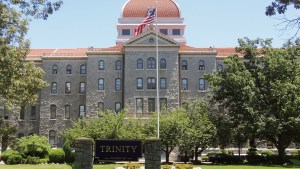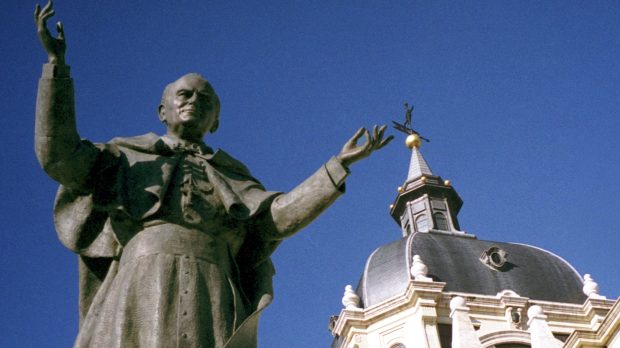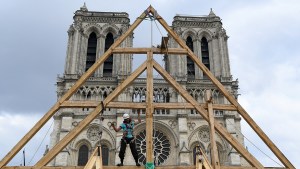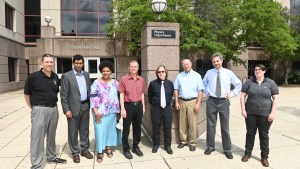Named “From the Heart of the Church” (Ex Corde Ecclesiae) the document clearly came from the heart of St. John Paul II. He shows great affection for higher education. The university was the place his vocation ripened, the place where he as a professor transformed the lives of lay people, and the place where he sees the future of the Church being formed.
The document is practical and effective. I work at a college that had 570 students total in 1991 — and after years of following Ex Corde Ecclesiae now has 600 students in the Freshman class alone. But most of its fruits still lie in the future.
Here are six things St. Pope John Paul II hoped to see from Catholic universities.
1: Catholic colleges will transform culture.
Catholic universities “give me a well-founded hope for a new flowering of Christian culture in the rich and varied context of our changing times,” he said.
Colleges created culture throughout history: St. Benedict and his followers created universities whose graduates still dress like Benedictines to get their degrees. Catholic universities launched St. Thomas Aquinas, who ushered in a new flowering of philosophy, and Dante, who sparked a new birth of artistic expression.
Closer to our time Catholic universities produced scientists such as Louis Pasteur, Gregor Mendel, Laura Bassi, Maria Gaetana Agnesi, and big-bang theorist Father Georges Lemaître — changing the way we see our world.
2: Catholic colleges guard the human person.
“What is at stake” in Catholic higher education, writes John Paul, “is the very meaning of the human person.”
It is no wonder that anxiety rates are rising, suicide rates are setting record, and a whole generation seems to feel lost. The markers of personal identity that stood for centuries have disappeared for many. Meanwhile, at Catholic universities that study theology of the body, the primacy of the family, and objective beauty, theologians, philosophers and sociologists are examining the remarkable ways that even in our broken state shows how we are created in the image of Jesus Christ, crucified and risen.
3: The search for truth lives on at Catholic colleges.
“A Catholic University’s privileged task is to unite … two orders of reality that too frequently tend to be placed in opposition,” writes John Paul: “the search for truth, and the certainty of already knowing the fount of truth.”
In the 21st century, many universities are abandoning the search for truth with disastrous consequences, say Jonathan Haidt and Greg Lukianoff in The Coddling of the American Mind: How Good Intentions and Bad Ideas Are Setting Up a Generation for Failure.
“The notion that a university should protect all of its students from ideas that some of them find offensive is a repudiation of the legacy of Socrates,” they write. They even propose a way of proceeding that is like John Paul II’s: “Argue as if you’re right, but listen as if you’re wrong.”
As Pope Benedict XVI urged this approach to academic freedom to American Catholic universities, saying, “you are called to search for the truth wherever careful analysis of the evidence leads you.”

4: Universities give lay people key Church roles.
“Lay people have found in university activities a means by which they too could exercise an important apostolic role in the Church,” writs St. John Paul. “The future of universities depends to a great extent on the competent and dedicated service of lay Catholics.”
A great example of this is Gottlieb Söhngen, a theologian described by his student, the future Pope Benedict XVI, as a “radical and critical questioner.” He relentlessly asked difficult questions, but remained deeply committed to the magisterium of the Church. In so doing, he formed one of the great minds of the 21st century.
In America, lay Catholic professors like John Senior, Mark Van Doren, Marshall MacLuhan, Mary Ann Glendon and Alasdair MacIntyre have had an enormous impact on the Church and the world.
5. Catholic colleges bring Christ into every sector of society.
“Every human reality…has been liberated by Christ,” writes John Paul. “Jesus Christ, our Savior, offers his light and his hope to all those who promote the sciences, the arts, letters and the numerous fields developed by modern culture.”
Jesus Christ is the way, the truth and the life. Through him all things were created and in him have their end. That means that he is relevant to every profession in some way. This is what a Catholic university is for — taking the complicated issues of the world, adding the light of Christ and transforming the culture from within.
St. John Paul II ends his document this way: “Your weighty daily task that becomes ever more important, more urgent and necessary on behalf of Evangelization for the future of culture and of all cultures.”




